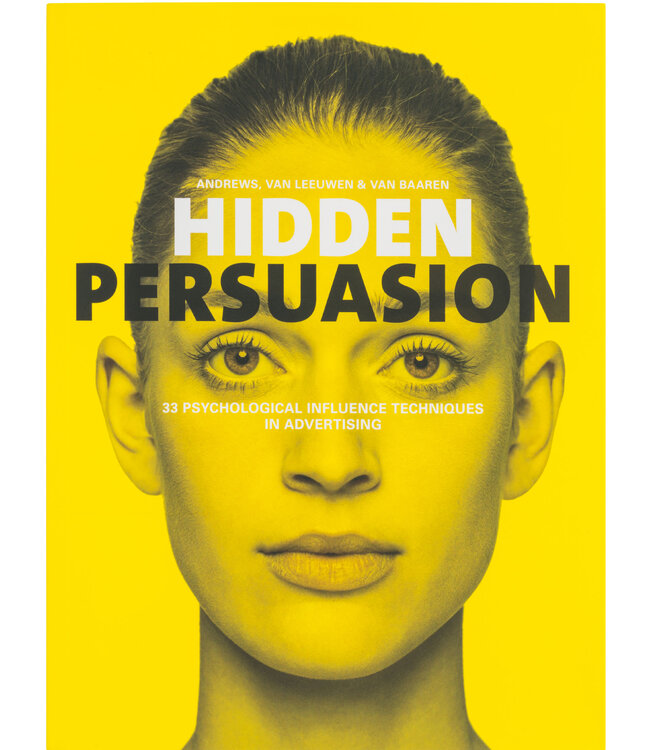Hidden Persuasion
This book analyzes advertising beyond the persuasive power of the imagery itself. It explains the psychology behind 33 effective influence techniques in visual persuasion and how to apply them.
Free shipping within the Netherlands
On orders of 20 euros and moreFast global delivery
Next day in NL, 1-5 business days in Europe and US, other countries ASAP
Product description
Visual messages are omnipresent in our daily life. They are constantly attempting to persuade us to buy, learn and act. Some are more successful than others in influencing our behavior and choices. What is the secret power of these messages? How do they succeed in changing our behavior?
This book analyzes advertising beyond the persuasive power of the imagery itself. It explains the psychology behind 33 effective influence techniques in visual persuasion and how to apply them.
The techniques range from influencing essentials to more obscure and insidious ones. The reader will gain deep insights into how visual means are constructed to influence behavior and decisionmaking on an unconscious level.
All techniques are supported by rich visual references and additional information on the psychology of behavior change. This publication is not just an eye-opener for professionals and students in the communications and design field, but also for anybody who wants to understand how our behavior is infl uenced unconsciously by advertising, social campaigns and governmental messages. The book is co-authored by leading figures in social infl uence and visual persuasion. It is designed as an accessible modern reference book for creating and understanding persuasive visual imagery. It will open your eyes, we promise!
Authors
Marc Andrews is a psychologist, art director and designer. He holds a master’s degree in Behavioural Science and a Master of Arts in Graphical/Editorial Design. In Design, he earned his master's degree (with honours) by exploring the rhetorical, semiotical, and psychological dimensions of visual argumentation. Since 2008, he has been a partner of andrews:degen (andrewsdegen.com), a creative agency for visual communication in Amsterdam. In addition, he teaches Design Psychology and Design Theory in The Netherlands, and has provided lectures and workshops on social design at several international design academies
Dr. Matthijs van Leeuwen is an assistant professor of Social Influence and Persuasion at the Radboud University of Nijmegen. His research focusses on direct and long-term change using high involvement persuasion techniques, and how to circumvent behavioural resistance. A second research focus is on exploring the unconscious associations that can predict future behaviour, using a wide array of implicit measurement tools. As a teacher, he lectures and instructs graduates and research masters students in the real-life application of scientifically validated influence techniques. Finally, he is a scientific advisor at db-abs (db-abs.com) and provides lectures for commercial and governmental agencies on behavioural resistance.
Prof. dr. Rick van Baaren is professor of Behavioural change and Society at Radboud University Nijmegen. His research focuses on different kinds of conscious and unconscious behavioural influence and has been published in authoritative international scientific journals. His work has also been featured in the New York Times, the Discovery Channel and Die Welt, among others. Furthermore, van Baaren is founder of the new and unique Master's programme “Behavioural Change” at Radboud University Nijmegen. This programme is dedicated to training master students to become behavioural change experts who combine an excellent scientific foundation with keen grasp of real world application. Finally, van Baaren serves as an external advisor on behavioural change for several agencies and television programmes.
Press
''The chosen themes are all about really relevant insights from recent scientific works.'' – Touchpoints
"These hidden persuasions are a driving force behind advertising, and they’re way more common than you might think." – Wired.com
"You’ll never look at an ad, an online shopping site or product packaging the same way again." – Nextavenue.org
Reviews
The Book was seductive and I was eager to look it up. Although it is clear and neatly organized, I have a problem with the illustrations : I find the total absence of date credits surprising, not to mention agency, as it sells itself as an advertising essay on its sub-title. Is there going to be an addition ? And is there any reason for this absence ?
Preview
Specifications
Hidden Persuasion
1 reviewThe Book was seductive and I was eager to look it up. Although it is clear and neatly organized, I have a problem with the illustrations : I find the total absence of date credits surprising, not to mention agency, as it sells itself as an advertising essay on its sub-title. Is there going to be an addition ? And is there any reason for this absence ?
Review Marc Andrews, Dr. van Leeuwen and Prof. Dr. van Baaren Hidden Persuasion
This book analyzes advertising beyond the persuasive power of the imagery itself. It explains the ps..












